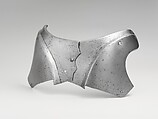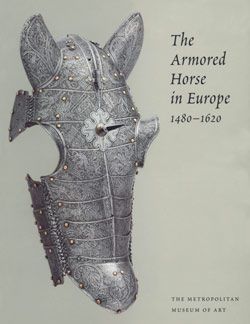Cantle Plates
Not on view
This two-piece cantle belongs to a style that appears to have been prevalent in Flanders in the late fifteenth and early sixteenth centuries and in England until the 1540s. Three key features distinguish the cantle plates of this Flemish/English style. First, the sides of the cantle extend forward in a narrow arm forming a sweeping, semicircular arc. Second, the upper edge of the arm is defined by an embossed ledge that falls in a gentle curve toward the bottom center of the cantle. Third, the top and side edges of the cantle plates are turned at a ninety-degree angle to form a strong but simple and well-defined border.
Several saddles with cantles of this form are included in the Inventario Iluminado, an illustrated inventory of the personal armory of Emperor Charles V drawn up in Spain between 1544 and 1558, in which they are shown among a large group of older pieces of armor described as having come from Flanders. Some of these saddles are still preserved in the Real Armería in Madrid (F5, F7, F9, and F15). Other examples include three set of saddle steels made in the Royal Workshops at Greenwich for Henry VIII (MMA acc. no. 19.131.2a, part of an armor dated 1527, and Royal Armouries Museum, Leeds, VI.96–97, made about 1544, and VI.98–99, made about 1540) and the saddle of the so-called Burgundian Bard, made in Flanders about 1511–14 and also from the armory of Henry VIII (Royal Armouries Museum, VI.6–12). The saddle of a miniature armor for man and horse, which was given to the Armourers and Braziers Company of London by one of its members in 1528, is also of this type.
Relatively little extant armor can be identified as Flemish, and even less as English, outside of that produced in the Royal Workshops at Greenwich. The stylistic attribution of these cantle plates to Flanders or England is therefore a small but nonetheless significant addition to this corpus of rare material.
Due to rights restrictions, this image cannot be enlarged, viewed at full screen, or downloaded.


